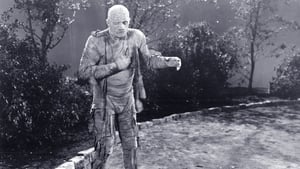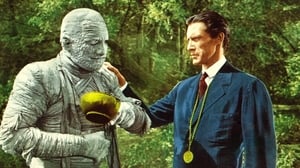Contact: info@alwanfilm.com
Video Sources 0 Views
- Watch trailer
- The Mummy's Ghost


Synopsis
Table of Contents
ToggleReview: The Mummy’s Ghost 1944 Colorized – Unearthing Ancient Horrors

Introduction
The Mummy’s Ghost, released in 1944, is a chilling addition to the classic horror genre, directed by Reginald Le Borg. Renowned for its eerie atmosphere, suspenseful plot, and iconic monster, this film continues to haunt audiences with its tale of ancient curses and undying love. In this review, we’ll delve into the dark and mysterious world of The Mummy’s Ghost and its enduring legacy in the realm of classic horror cinema.
Check The Full Colorized Movies List
Check Our Colorized Movies Trailer Channel
Understanding The Mummy’s Ghost 1944 Colorized: Director, Cast, and Genre
Directed by Reginald Le Borg, The Mummy’s Ghost features a talented cast led by Lon Chaney Jr. in the role of the titular mummy, Kharis. The film belongs to the classic horror genre, known for its eerie atmosphere, supernatural elements, and iconic monsters.
Exploring the World of The Mummy’s Ghost 1944 Colorized Plot and Characters
The Mummy’s Ghost continues the story of Kharis, an ancient Egyptian priest who is resurrected from the dead to seek revenge on those who desecrated the tomb of his beloved Princess Ananka. As Kharis embarks on a murderous rampage through the streets of a small town, he becomes entangled in a web of forbidden love and dark magic, leading to a thrilling climax that will leave viewers on the edge of their seats.
The Art of Film Colorization
While The Mummy’s Ghost was originally filmed in black and white, its early colorized version adds a new layer of depth to its eerie atmosphere and supernatural visuals. The colorization process enhances the film’s spooky ambiance and captures the otherworldly allure of its ancient Egyptian setting with striking clarity.
Early Colored Films: A Brief History
The history of early colored films is marked by innovation and experimentation as filmmakers sought to enhance the visual appeal of their movies. From hand-tinted frames to pioneering technicolor processes, the evolution of colorization techniques transformed the cinematic landscape, offering audiences a new way to experience the magic and mystery of classic horror cinema.
The Mummy’s Ghost (1944) and Its Early Colored Version
The decision to release The Mummy’s Ghost in a colorized format was made with the intention of immersing audiences in the eerie beauty of its ancient Egyptian setting and enhancing the film’s visual impact. While some purists may prefer the original black and white version, the early colorized edition of The Mummy’s Ghost adds a new layer of depth to its supernatural visuals and captures the chilling allure of its undead antagonist with breathtaking clarity.
The Debate Over Film Colorization
The debate over film colorization continues to divide audiences and industry professionals alike. While some argue that colorization breathes new life into classic films and makes them more accessible to modern audiences, others maintain that it compromises the artistic integrity of the original work. As technology advances and filmmaking techniques evolve, the debate over colorization remains a topic of ongoing discussion within the film community.
Examining The Mummy’s Ghost (1944) as an Early Colored Film
Viewing The Mummy’s Ghost in its early colorized iteration offers audiences a fresh perspective on its eerie atmosphere and supernatural elements. The colorization process enhances the film’s spooky ambiance and captures the otherworldly allure of its ancient Egyptian setting with stunning clarity. As viewers are drawn into the dark and mysterious world of Kharis, they are treated to a visual feast that immerses them in the magic and mystery of classic horror cinema.
Influence and Legacy: The Mummy’s Ghost 1944 Colorizeds Impact on Cinema
The Mummy’s Ghost is widely regarded as a classic of the horror genre that continues to captivate audiences with its eerie atmosphere, suspenseful plot, and iconic monster. Its tale of ancient curses and undying love has left an indelible mark on the realm of classic horror cinema, inspiring countless imitators and homages in the decades since its release.
Director’s Cinematic Legacy: Beyond The Mummy’s Ghost 1944 Colorized
Reginald Le Borg’s directorial legacy extends far beyond The Mummy’s Ghost, encompassing a diverse body of work that includes numerous entries in the horror genre. As a master of suspense and atmosphere, Le Borg was known for his ability to craft chilling tales of the supernatural that kept audiences on the edge of their seats. The Mummy’s Ghost stands as a testament to his talent and creativity, solidifying his reputation as one of the great auteurs of classic horror cinema.
Themes Explored in The Mummy’s Ghost 1944 Colorized
At its core, The Mummy’s Ghost explores themes of ancient curses, forbidden love, and the quest for eternal life. Through its eerie atmosphere and supernatural elements, the film offers a chilling portrayal of the dark and mysterious forces that lurk in the shadows, waiting to be unleashed upon unsuspecting victims.
Reception and Controversy Surrounding The Mummy’s Ghost 1944 Colorized
Upon its release, The Mummy’s Ghost received widespread acclaim for its eerie atmosphere, suspenseful plot, and iconic monster. While the decision to release the film in a colorized format sparked debate among purists, its enduring popularity has cemented its status as a classic of the horror genre.
Where to Watch The Mummy’s Ghost 1944 Colorized Online
For those eager to experience The Mummy’s Ghost for themselves, the film is readily available on popular streaming platforms such as Amazon Prime Video, Google Play Movies, and iTunes. Whether viewed in its original black and white format or its early colorized iteration, The Mummy’s Ghost offers a cinematic experience that is both chilling and visually stunning.
FAQs About The Mummy’s Ghost 1944 Colorized
1. Is The Mummy’s Ghost based on a true story?
No, The Mummy’s Ghost is a fictional film that draws inspiration from the classic horror tropes of ancient curses and undead monsters. While the film’s storyline may incorporate elements of real-life mythology, its characters and plot are works of fiction.
2. Who starred in The Mummy’s Ghost?
The Mummy’s Ghost stars Lon Chaney Jr. in the role of Kharis, the titular mummy who is resurrected from the dead to seek revenge on those who desecrated the tomb of his beloved Princess Ananka. He is supported by a talented ensemble cast, including John Carradine, Ramsay Ames, and Barton MacLane.
3. What is the central message of The Mummy’s Ghost?
At its core, The Mummy’s Ghost explores themes of ancient curses, forbidden love, and the quest for eternal life. Through its eerie atmosphere and supernatural elements, the film offers a chilling portrayal of the dark and mysterious forces that lurk in the shadows, waiting to be unleashed upon unsuspecting victims.
4. Why was The Mummy’s Ghost released in a colorized format?
The decision to release The Mummy’s Ghost in a colorized format was made with the intention of immersing audiences in the eerie beauty of its ancient Egyptian setting and enhancing the film’s visual impact. While some purists may prefer the original black and white version, the early colorized edition of The Mummy’s Ghost adds a new layer of depth to its supernatural visuals and captures the chilling allure of its undead antagonist with breathtaking clarity.
5. What is the legacy of The Mummy’s Ghost?
The Mummy’s Ghost is widely regarded as a classic of the horror genre that continues to captivate audiences with its eerie atmosphere, suspenseful plot, and iconic monster. Its tale of ancient curses and undying love has left an indelible mark on the realm of classic horror cinema, inspiring countless imitators and homages in the decades since its release.
6. Are there any sequels or remakes of The Mummy’s Ghost?
Yes, The Mummy’s Ghost is part of a series of films featuring the character of Kharis, including The Mummy’s Hand (1940), The Mummy’s Tomb (1942), and The Mummy’s Curse (1944). While these films share similar themes and characters, each installment offers a unique take on the classic mummy mythos.
7. Where can I watch The Mummy’s Ghost online?
For those eager to experience The Mummy’s Ghost for themselves, the film is readily available on popular streaming platforms such as Amazon Prime Video, Google Play Movies, and iTunes. Whether viewed in its original black and white format or its early colorized iteration, The Mummy’s Ghost offers a cinematic experience that is both chilling and visually stunning.
Conclusion
In conclusion, The Mummy’s Ghost (1944) stands as a chilling addition to the classic horror genre, offering audiences a tantalizing glimpse into the dark and mysterious world of ancient curses and undying love. Whether viewed in its original black and white format or its early colorized iteration, Reginald Le Borg’s insightful direction and Lon Chaney Jr.’s iconic performance as Kharis the mummy offer a cinematic experience that is both eerie and visually stunning.
As viewers are drawn into the supernatural realm of ancient Egypt, they are treated to a spine-tingling journey that will leave them breathless with suspense and anticipation. The Mummy’s Ghost remains a timeless classic that continues to haunt and inspire audiences around the world.












